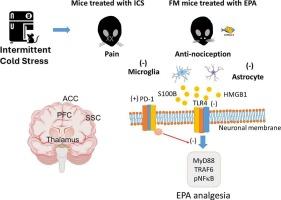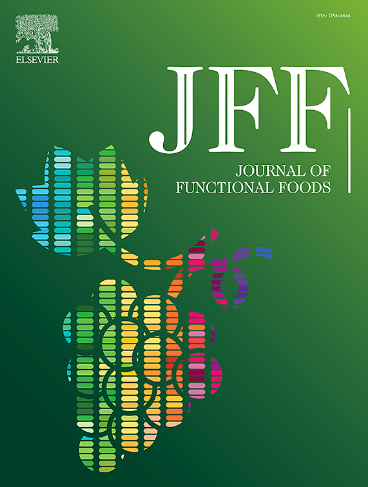二十碳五烯酸通过抑制小鼠大脑中的小胶质细胞/星形胶质细胞和toll样受体4通路来减轻纤维肌痛疼痛
IF 4
2区 农林科学
Q2 FOOD SCIENCE & TECHNOLOGY
引用次数: 0
摘要
二十碳五烯酸(EPA)在纤维肌痛(FM)中的作用是有限的。FM被定义为持续数月的疼痛,是一个日益增加的医学挑战,对患者、经济和社会都有重大影响。采用间歇性冷应激(ICS)建立FM疼痛小鼠模型。疼痛小鼠模型在ICS诱导后产生机械性(2.07±0.12 g)和热性(4.55±0.36 s)痛觉过敏。结果表明,口服EPA (100 mg/kg/d, 3.52±0.12 g和7.11±0.37 s)可减轻ICS的有害影响。小胶质细胞、星形胶质细胞和toll样受体4信号通路在FM小鼠的伤害性上升通路中过度表达,包括丘脑、体感觉皮层、前扣带皮层和内侧前额叶皮层,这些通路与FM的发生有关。这些现象可以在EPA的管理下进一步减弱。EPA的摄入对FM管理有益。本文章由计算机程序翻译,如有差异,请以英文原文为准。

Eicosapentaenoic acid reduces fibromyalgia pain by inhibiting the microglia/astrocyte and toll-like receptor 4 pathway in the mouse brain
The role of eicosapentaenoic acid (EPA) in fibromyalgia (FM) pain are limited. FM, defined as pain that persists for several months, is an increasing medical challenge with significant implications for patients, the economy, and society. A FM pain mouse model was performed using intermittent cold stress (ICS). Mechanical (2.07 ± 0.12 g) and thermal (4.55 ± 0.36 s) hyperalgesia was initiated after ICS induction in the FM pain mouse model. Results showed that the detrimental effects of ICS were relieved via the oral administration of EPA (100 mg/kg/day, 3.52 ± 0.12 g and 7.11 ± 0.37 s). The overexpression of the microglia, astrocyte, and toll-like receptor 4 signaling pathways was found in the nociceptive ascending pathway of FM mice, including the thalamus, somatosensory cortex, anterior cingulate cortex, and medial prefrontal cortex, which is associated with FM initiation. These phenomena could be further attenuated by EPA administration. EPA intake can be beneficial for FM management.
求助全文
通过发布文献求助,成功后即可免费获取论文全文。
去求助
来源期刊

Journal of Functional Foods
FOOD SCIENCE & TECHNOLOGY-
CiteScore
9.60
自引率
1.80%
发文量
428
审稿时长
76 days
期刊介绍:
Journal of Functional Foods continues with the same aims and scope, editorial team, submission system and rigorous peer review. We give authors the possibility to publish their top-quality papers in a well-established leading journal in the food and nutrition fields. The Journal will keep its rigorous criteria to screen high impact research addressing relevant scientific topics and performed by sound methodologies.
The Journal of Functional Foods aims to bring together the results of fundamental and applied research into healthy foods and biologically active food ingredients.
The Journal is centered in the specific area at the boundaries among food technology, nutrition and health welcoming papers having a good interdisciplinary approach. The Journal will cover the fields of plant bioactives; dietary fibre, probiotics; functional lipids; bioactive peptides; vitamins, minerals and botanicals and other dietary supplements. Nutritional and technological aspects related to the development of functional foods and beverages are of core interest to the journal. Experimental works dealing with food digestion, bioavailability of food bioactives and on the mechanisms by which foods and their components are able to modulate physiological parameters connected with disease prevention are of particular interest as well as those dealing with personalized nutrition and nutritional needs in pathological subjects.
 求助内容:
求助内容: 应助结果提醒方式:
应助结果提醒方式:


